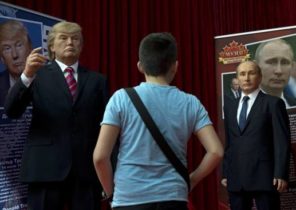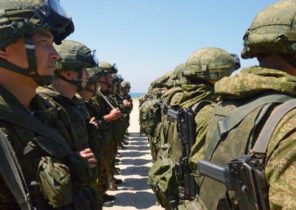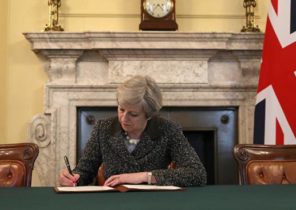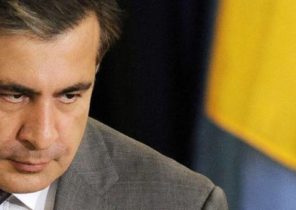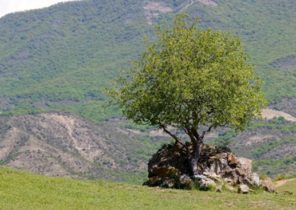In the spring of 2014 the Russian President Vladimir Putin leads in Ukraine hybrid war, not to allow the country to go with the Kremlin’s orbit. This unconventional campaign includes military, economic, diplomatic and informational methods. In the heart of all this lies the historical claims of Russia for a significant part of modern Ukraine. Putin is not even trying to hide his contempt for Ukrainian statehood. On the contrary, he argues that Ukraine has always been a primordial Russian land and it will continue, like it or not the Ukrainians.
The last six years, Putin has repeatedly stated that the occupied Donbas in Eastern Ukraine — an important element of Russian national heritage. In the notorious speech in April 2014, marking the next phase of the war in the Ukraine after the annexation of Crimea, he stated that the Donbass never was Ukrainian and was inexplicably transferred to the Soviet Ukraine in 1920. “God knows why” — he threw up his hands Putin. Recently, at the annual press marathon in December 2019 Putin called Donbass “primordial Russian lands that never had any relation to Ukraine.”
A selective view of the past may correspond to Putin’s political goals, but more careful investigation does not stand up. In fact, the Ukrainian presence in the disputed region of Donbas in Eastern Ukraine stretches for centuries, and the European roots of the region ridiculed the Kremlin’s attempts to put his sacred Russian land.
Simplistic statement of Putin hides the picture is much more complex. For centuries the Donbass and Eastern Ukraine was part of the “Wild field”, a large strip of sparsely populated border territories that stretched through the Ukrainian steppes, separating the Slavic state North of the Crimean khanate and the Ottoman Empire in the South.
At the end of the sixteenth century the rulers of the Polish-Lithuanian Commonwealth recognized the right of the Ukrainian Cossacks to settle in the Donbas to the don river. In the eighteenth century against the background of Russo-Turkish wars there surged a new wave of immigrants, and the Russian Queen Catherine the Great was seduced by a newly arrived land.
Most of the settlers were Ukrainians, but it came a lot of Russians, Romanians, Serbs, Hungarians and Germans as well as ethnic Greeks from neighboring Crimea. Therefore, the Donbas was one of the most cosmopolitan parts of the Russian Empire. In the Donbass, and today is home to a significant Greek population, mainly in Mariupol and around it.
The next turning point in the development of the Donbass was the industrial revolution of the nineteenth century. Thanks to the rich mineral resources, the region has become an important European centre, where he directed the new stream of adventurers and Industrialists from all over the continent. Many saw Parallels between the explosive growth of Donbass and westward expansion in North America, is the Russian author Alexander Blok even named the region “New America.”
Many large cities of Donbass owe their birth to the international experts, who brought the region its know-how. The most famous example — Donetsk, now the largest city of Donbass and the center of the Russian occupation. The founder of Donetsk was a British steel magnate John Hughes (John Hughes). Future Donetsk he founded in 1869. Initially, the village was even called Yuzovka in his honour.
Hughes was not the first British industrialist who left his mark in the Donbass. In 1795, his brother Charles Gascoigne (Charles Gascoigne) and the German Gustav Hartmann (Hartmann Gustav) founded two factories, of which later grew the city of Lugansk, the capital of another Russian separatist Republic in Eastern Ukraine.
Around British and German Industrialists have developed a very cosmopolitan environment where the act and representatives of other Western European countries — France, Italy and Belgium. The Belgian presence was so noticeable that the region some time was considered a major factor in the development of its economy. Worked in Mariupol and American Industrialists.
The international explosion of industry in the Donbas region in the nineteenth century affected the demographic composition of the region. However according to the Imperial census of 1897, the region remained predominantly Ukrainian. This is the only census for the entire pre-revolutionary era, and its data do not leave a bold historical claims Putin no stone unturned.
According to the 1897 census, the population of Ekaterinoslav province, which encompassed much of modern Donbass, including Donetsk and Lugansk, was 2.1 million. The majority of these, 68.9 per cent were Ukrainians. Russians constituted only 17.3%.
The same pattern was observed in rural areas. The population of the Mariupol district, numbering 254, 056 people, it was almost 50% Ukrainian, along with Russian (35 691) were many German, Greek, Jewish and Tatar communities. In light of these figures, any attempt to deny the historical ties of Ukraine with the Donbass are doomed to failure.
These facts remain largely unknown, both within Ukraine and abroad. In recent years, the awareness is gradually improving, thanks to renewed interest in the history of the region. However, the cosmopolitan past of the Donbass continues to be marred by incorrect russocentrism stereotypes that fit into the geopolitical agenda of the Kremlin.
Although Ukrainian roots, and European character of pre-Soviet Donbass is not in doubt, but in the decades after the Russian revolution, the region has undergone profound changes.
Many Ukrainians from rural areas have become victims of the Stalinist famine of the 1930s years, which claimed millions of lives and altered the demographic landscape of the Donbas. In addition, since the 1920-ies in the region surged a lot of people from all over the USSR to work on the many mines and industrial enterprises. Thus, the population of Donetsk has increased from 106 thousand in 1926 to 700 thousand by the end of 1950-ies.
The “Sovietization” of Donbass in the future, contributed to the wave of Stalinist repression of the 1930-ies, which have disproportionately hit the non-Russian ethnic groups. Ukrainians as the most numerous group were hit the hardest. Greek, German and Polish communities of the region, too, were bloodless. In addition, the Ukrainian, Greek, German, and other European place names disappeared from the map of Donbass, — they were replaced by typical Soviet alternative.
These attempts to erase the history of Donbass turned out to be surprisingly successful. As a result, by 1991, the region appeared to be a sort of Bastion of Russian-speaking Ukraine with a distinct Soviet identity that reflect the multiethnic composition of the population with roots all over the former USSR.
None of this have not yet made the current war in the Donbas is inevitable. Independent Ukraine bears some of the blame for what was not involved in the development of Donbass and left the region at the mercy of the Party of regions and other Pro-Russian political forces. However, before the Kremlin intervention, few could have imagined that the Pro-Russian political sympathies of the region will lead to armed struggle.
Russia’s hybrid war against Ukraine skillfully uses demographic transformations of the twentieth century, transforming the ethnically diverse region with a Ukrainian majority in the predominantly Russian-speaking area, featuring the powerful Soviet nostalgia and Pro-Kremlin sentiments. Calling the Donbass part of the “Russian world,” Putin relies on mass ignorance of the history of Donbass, ignoring key aspects of the integrated development of the region.
The true story of Donbass clearly points to its deep European roots and strong ties with the Western world. Raising awareness about this may be a step towards countering Putin’s manipulation, to undermine the Russian hybrid war and the reintegration of the occupied territories with the rest of Ukraine.
Alvydas of Medalinskas, a former Lithuanian Deputy. Political analyst at the University of Mykolas remerica in Vilnius and Deputy Chairman of the NGO “Donbass gate” in Mariupol.
